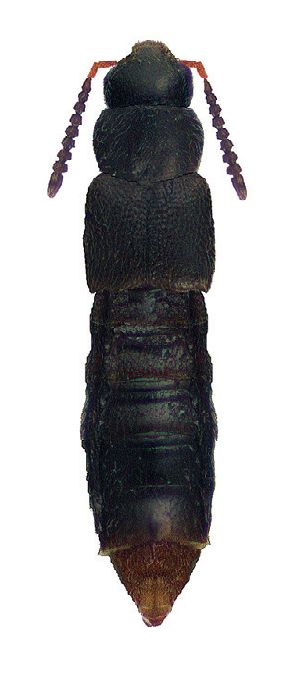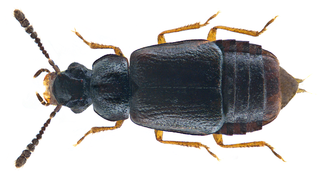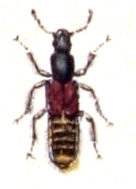
The rove beetles are a family (Staphylinidae) of beetles, primarily distinguished by their short elytra that typically leave more than half of their abdominal segments exposed. With over 66,000 species in thousands of genera, the group is the largest family in the beetle order, and one of the largest families of organisms. It is an ancient group, with fossilized rove beetles known from the Triassic, 200 million years ago, and possibly even earlier if the genus Leehermania proves to be a member of this family. They are an ecologically and morphologically diverse group of beetles, and commonly encountered in terrestrial ecosystems.

The Omaliinae are a subfamily of the Staphylinidae, rove beetles.

Coprophilus is, with about 30 species, a genus of staphylinid beetles. They are confined to temperate regions of the Northern Hemisphere. They are generally found in rotting plants and woods, compost, under leaf litter, and near herbivore dung, hence their generic name.

Paederus is a genus of small beetles of the family Staphylinidae. With 622 valid species assigned by 1987 to the subtribe Paederina, and with all but 148 within Paederus itself, the genus is large. Due to toxins in the hemolymph of some species within this genus, it has given its name to paederus dermatitis, a characteristic skin irritation that occurs if one of the insects is crushed against skin. That name, Paederus dermatitis, is a poor choice because, decades earlier, the affliction had been called dermatitis linearis, a name that works in all languages, not just English, because of its Latin origin; the name Paederus dermatitis is also inappropriate because it has shown to be caused by (a) only a few species of the genus Paederus, but (b) also a few species that belong to closely related genera within the subtribe Paederina. A scholarly paper in 2002 suggested that a Paederus species could have been responsible for some of the ten Plagues of Egypt described in the Bible's Book of Exodus.

Priochirus unicolor is a species of beetles belonging to the family Staphylinidae. This species can be found in Indonesia.

The Oxytelinae are a subfamily of the Staphylinidae, rove beetles. There are about 20 genera and at least 320 described species in Oxytelinae.

Drusilla canaliculata is a species of rove beetle in the family Staphylinidae. It is found in Europe and Northern Asia and North America.

Staphylinini is a tribe of large rove beetles in the family Staphylinidae. There are at least 20 genera and 120 described species in Staphylinini.

Leptusa carolinensis is a species of rove beetle in the family Staphylinidae. It is found in North America.

Leptusa is a genus of rove beetles in the family Staphylinidae. There are at least 20 described species in Leptusa.

Anthophagini is a tribe of ocellate rove beetles in the family Staphylinidae. There are at least 20 genera and 20 described species in Anthophagini.

Mycetoporini is a tribe of crab-like rove beetles in the family Staphylinidae. There are about 8 genera and at least 20 described species in Mycetoporini.

Omalium is a genus of ocellate rove beetles in the family Staphylinidae. There are at least 70 described species in Omalium.

Omaliini is a tribe of ocellate rove beetles in the family Staphylinidae. There are about 45 genera and 450 described species in Omaliini.
Aploderus is a genus of beetles belonging to the family Staphylinidae.
Ischnosoma is a genus of beetles belonging to the family Staphylinidae.
Encephalus is a genus of beetles belonging to the family Staphylinidae.

Othius is a genus of beetles belonging to the family Staphylinidae.
Oxytelus migrator is a species of rove beetle widely spread in Asia and Europe. It is found in China, Hong Kong, Japan, Vietnam, Thailand, Malaysia, Indonesia, and Sri Lanka.

Stenus melanarius is a species of rove beetle widely spread in Asia and Europe. It is a natural predator of the pest, Cnaphalocrocis medinalis.















